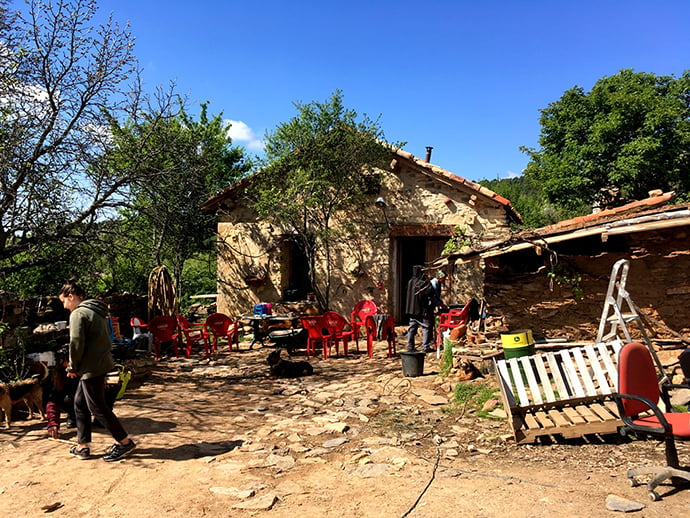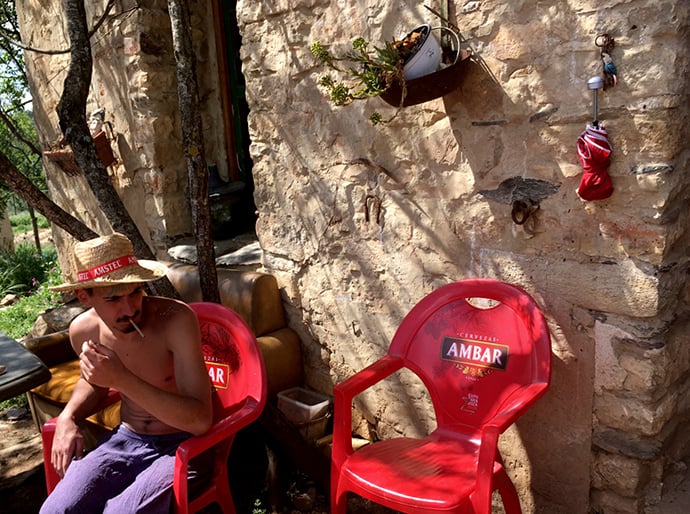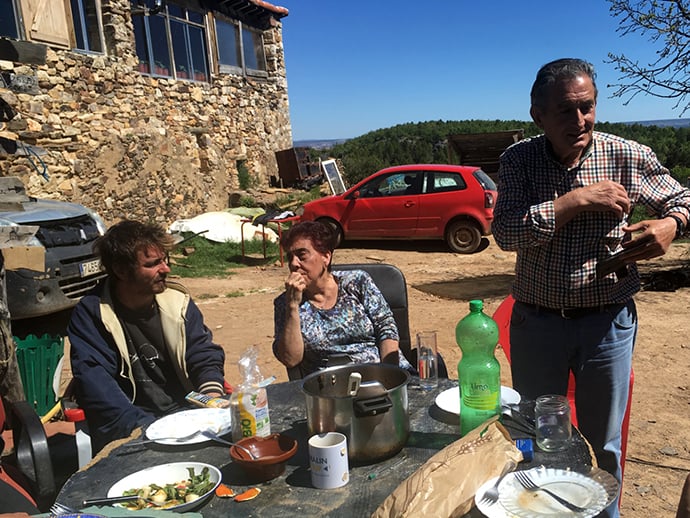Horizontal World
After rebuilding Fraguas, a town destroyed under Franco, Spanish squatters face eviction
On a warm day in May, I visited a town that wasn’t supposed to exist. Jorge Martín, a gangly man with a wispy voice, picked me up at a train station fifty miles northeast of Madrid. We drove up a winding road, through stately rows of pine trees on red clay terraces, skirting the base of the Sierra Norte mountains. Half an hour later, we pulled up at the foot of a dirt knoll surrounded by fields of overgrown grass. Four stone houses rose from the hill. We had arrived in Fraguas.

The Casa Cándida is the central gathering space in Fraguas, where residents cook, hold meetings, and play cards at night.
We walked to a house called Casa Cándida. Martín waved to a few thirty-year-olds in tank tops who lounged on a worn yellow couch. Two scruffy dogs dozed in the shade of a mulberry tree. I followed a one-eyed cat named Guiño, Spanish for “wink,” into the house, where stickers reading “Fraguas libertad,” “Out with Nazis in our neighborhoods,” and “Antifa is watching you,” decorated the kitchen walls.
Back outside, Martín grabbed a scythe from a shed and said he was going to the garden to pull weeds. “Enjoy the pueblo,” he told me, grinning.
Near the shed, Lucille Ogier and her boyfriend Jaime Pareja planted marigold seeds in a shallow bed of soil. “The beautiful thing here is that there’s no pressure, no schedule, each person does what they want,” Pareja said. A thirty-year-old named César, who sipped a beer on the couch, added, “Life here is different. You have to learn about coexistence.”
In a house farther up the hill, Lalo Aracil, a short thirty-four-year-old with a mullet typical of Spanish leftists, was building a bathroom. His pants were splattered with cement, and a cigarette dangled from his lips as he pushed a wheelbarrow. His face was leathery, tanned from years of outdoor work, six of which he’d spent in Fraguas. When he finished for the day, he reclined on a swiveling office chair set in the dirt. As he took swigs of boxed red wine mixed with Coca-Cola from an old pickle jar, he told me about the history of the town.
Once a small farming village, Fraguas had in the past half-century been emptied, destroyed, and rebuilt. When I visited, it was on the verge of being destroyed once again.
The tumult dates to the 1960s, when dictator Francisco Franco’s forest service bought the village and planted thousands of acres of pine trees in the surrounding hills, forcing the residents out. In the 1980s, the Spanish military used the vacant town as a training ground, destroying the remaining houses. Over time, thick weeds and grass crept over the crumbling ruins. Fraguas disappeared.
But six years ago, as young Spaniards reeling from the financial crisis began squatting in abandoned houses across the country, Aracil and several others stumbled upon what was left of the old town. The group was looking for a place to build a self-sustaining rural outpost and Fraguas, with its proximity to natural springs, fruit trees, and wild mushrooms, seemed like an ideal spot. A group of fifteen squatters decided to settle there, living in tents and trucks as they built their first house. They were full of idealism, with plans to plant a garden, construct an irrigation system, maybe take up beekeeping. There would be no leader, no hierarchy. There would be no rent, little spending. They wanted to distance themselves from the Spanish state and survive off the land. They called themselves Fraguas Revive, Fraguas Lives Again.
The utopian dream wouldn’t last long. The winter after they broke ground, members of the Guardia Civil, Spain’s national police force, appeared at the construction site and took down names. The Junta de Castilla-la Mancha, the regional government, accused Fraguas Revive of unlawful occupation and illegal construction in a natural park. And last year, the six people who had been working the day the police showed up were each sentenced to eighteen months in prison and fined nearly three thousand euros. The government also ordered that the four houses the group had built be destroyed. Fraguas Revive would have to pay thirty thousand euros to return the town to ruins.
Fraguas Revive has appealed the ruling, but the sentence has been upheld. In May, a court denied their second appeal. An eviction notice could arrive any day. Still, the group is determined to stand their ground. “We’re not going to leave,” Aracil said.

Fraguas volunteer José Vi takes a break from construction work to smoke outside the Casa Cándida.
Before Fraguas, Aracil spent a decade squatting in various places across central Spain. He studied biology at the Complutense University in Madrid, but dropped out to squat around the city and participate in social justice movements, rallying for fair housing laws and alternative ways of living. For Aracil, squatting was to live peacefully with others without state interference. “Liberty was the principal concern,” Aracil said. “And to arrive at this, to be free from the state… you have to construct a horizontal world.”
Squatting is a political philosophy born of discontent, a means to reject capitalism and live outside the state apparatus. In Spain, historically, the movement has been both political and practical. When Franco died in 1975 and Spain began its democratic opening, people squatted to express their newfound freedom. They were also responding to an urban housing shortage. To define their movement, they coined a new term, okupar, whose letter “k,” rare in Castilian Spanish, was an intentional misspelling, a nod toward the transgressive nature of the act. A subset of squatters moved to the countryside, where hundreds of towns had been left abandoned after mass migration to cities in the 1960s. Their movement, known as neo-ruralism, championed self-sufficiency.
Three decades later, during Spain’s financial crisis, a resurgent squatting movement took hold. In 2009, a credit-fueled construction boom went bust and thousands of flats around Spain were abandoned or reclaimed by banks. The Spanish government imposed harsh austerity measures, and in protest, thousands of young Spaniards occupied Madrid’s central square. Grassroots fair housing movements emerged to prevent evictions. Today, there are at least eighty-seven thousand squatted homes or flats in Spain.
While in Madrid, Aracil squatted in five different places, moving often. But over time he grew tired of city life. He spent too much money, and felt caught up in the frantic pace. In 2010, he moved to a pueblo okupado in the mountains outside of Madrid, yet soon left because he found its residents too individualistic. Aracil then moved to the nearby Toledo province and worked at a grocery cooperative.
He longed for the mountains, for the sense of freedom he had discovered in the countryside. Even more, he wanted a place close to home where he could start from the ground up and establish norms that would adhere to his worldview. Through his fair housing activism, Aracil met other young people who were similarly searching for a way to manage their own resources and live in a leaderless community. “We had political interests that brought us together,” Aracil said. “The best medium we had was the countryside.”

Fraguas squatters plant potatoes, lettuce, onions, and other vegetables in their garden. They hope to one day produce all of their food items.
The morning after I arrived, Aracil made me a cup of bitter coffee and led me to the kitchen window. “See those,” he said, pointing to a shock of green treetops rising from a distant ridge. “Those oak trees stopped a fire here a few years ago.”
As the story goes, the fire blazed through acres of pines, planted fifty years earlier by Franco’s forest service, but left the native oak trees unscathed. Aracil, like the other members of Fraguas Revive, knew the history of the pines well: after Franco’s nationalists won the Spanish Civil War in 1939, the dictator ordered hundreds of thousands of pines and eucalyptus trees, which are highly flammable, planted across the country. His program had two stated aims: to recuperate forests Spaniards had exploited in the middle ages, and to build reservoirs, which pines would protect from erosion. By quantitative measures, the program was a success: within thirty years, Franco’s forest service had planted three million hectares of trees.
Spain is a country deeply divided on Franco’s legacy, and his reforestation program is yet another battleground in historical interpretation. Detractors argue that Franco sought to enrich paper manufacturers and bring energy to major urban centers at the expense of rural towns, some of whose residents were evicted to plant the trees.
“It was a military thing,” Santiago Fernández Muñoz, a geography professor at the University Carlos III in Madrid, told me. “It wasn’t a democratic regime where you could protest against the authorities.”
In 1968, officials arrived in Fraguas, then home to around twenty families, and offered to buy the village and its surrounding farmland for three million pesetas. Residents had little choice but to leave the town where their ancestors had raised livestock for centuries.
“It’s a bit ironic they accuse us of this, of usurpation,” Aracil said of the government. “Because the Francoist state… they were the usurpers. They robbed the properties and lands from their old owners…. They erased them from the map.”

Former Fraguas resident Isidro Moreno García recounts his memories of the town to the squatters over lunch.
On my last day in Fraguas, as six of us sat outdoors eating a lunch of bramble stew and chickpea patties that Martín had cooked, a silver-haired man ambled up from behind the ruins of an old church. It was Isidro Moreno García, a retiree in his seventies who had grown up in Fraguas before its residents were evicted. Aracil’s face lit up in surprise. “Hombre!” he exclaimed, standing up to shake Moreno’s hand.
Moreno met Aracil in 2013, when Fraguas Revive was building its first house. He sometimes returned to reminisce and visit his great-grandfather’s grave. He envies other Spaniards who can return to their villages for the summer, as is typical in Spain. For Moreno, the demolition of Fraguas was more than an act of physical destruction. It represented the erasure of his childhood. Gone is the schoolyard where he and his friends played on warm afternoons, the plaza where merchants would travel by mule to deliver sugar, and the stone house where he was born.
When Moreno sat down, the group peppered him with questions. Where had the villagers kept their sheep and goats at night? Had they grown fruit trees? Had they made their own cheese?
Moreno leaned forward in his chair and began telling stories of the Fraguas he knew. He was angry with the regional government for their stance toward Fraguas Revive—“they are the ones who deserve life sentences,” he said—but he was pleased to see young people rebuilding his village, despite the threat of eviction.
“Those stones that are dead,” he told me, “they’ve taken on a new life.”







































































































